Endeavour retired
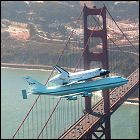 NASA donates the retired Space Shuttle Endeavour, stripped of working engines and other vital equipment, to the California Science Center in Los Angeles. The last shuttle to be built, construction on Endeavour began in 1988 from spare parts to replace the destroyed Challenger; Endeavour lifted off for the first time in 1992, ultimately flying 25 missions, including many of the International Space Station construction missions. This also marks the final flight of the modified Boeing 747 shuttle carrier aircraft, which flew for the first time in 1977.
NASA donates the retired Space Shuttle Endeavour, stripped of working engines and other vital equipment, to the California Science Center in Los Angeles. The last shuttle to be built, construction on Endeavour began in 1988 from spare parts to replace the destroyed Challenger; Endeavour lifted off for the first time in 1992, ultimately flying 25 missions, including many of the International Space Station construction missions. This also marks the final flight of the modified Boeing 747 shuttle carrier aircraft, which flew for the first time in 1977.
STS-134: Endeavour’s final flight
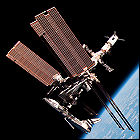 Space Shuttle Endeavour lifts off on its final flight into orbit, carrying an alpha magnetic spectrometer instrument and supplies to the International Space Station during a 16-day mission. This is Endeavour’s 25th and final launch. The crew for this mission consists of Commander Mark Kelly, Pilot Greg Johnson, and mission specialists Mike Fincke, Drew Feustel, Greg Chamitoff and Roberto Vittori.
Space Shuttle Endeavour lifts off on its final flight into orbit, carrying an alpha magnetic spectrometer instrument and supplies to the International Space Station during a 16-day mission. This is Endeavour’s 25th and final launch. The crew for this mission consists of Commander Mark Kelly, Pilot Greg Johnson, and mission specialists Mike Fincke, Drew Feustel, Greg Chamitoff and Roberto Vittori.
Retirement homes for Space Shuttles
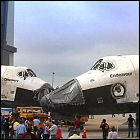 NASA announces the results of a bidding process for soon-to-be-retired Space Shuttle vehicles by institutions across the country. The original test vehicle, Enterprise, will be removed from the Smithsonian and replaced by the space-flown Discovery, while Atlantis will become the centerpiece of a new exhibit at NASA’s own Kennedy Space Center. Endeavour will be handed over to the California Science Museum in Los Angeles, while Enterprise’s new home will be in New York City’s Intrepid Museum. Institutions not selected to receive one of the shuttles, including NASA’s Johnson Space Center in Houston, Texas, almost immediately claim that the selection process has been swayed by politics. None of the vehicles will be transported from Kennedy Space Center to their new locations until the following year.
NASA announces the results of a bidding process for soon-to-be-retired Space Shuttle vehicles by institutions across the country. The original test vehicle, Enterprise, will be removed from the Smithsonian and replaced by the space-flown Discovery, while Atlantis will become the centerpiece of a new exhibit at NASA’s own Kennedy Space Center. Endeavour will be handed over to the California Science Museum in Los Angeles, while Enterprise’s new home will be in New York City’s Intrepid Museum. Institutions not selected to receive one of the shuttles, including NASA’s Johnson Space Center in Houston, Texas, almost immediately claim that the selection process has been swayed by politics. None of the vehicles will be transported from Kennedy Space Center to their new locations until the following year.
STS-130
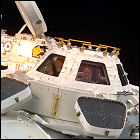 Space Shuttle Endeavour lifts off on the 130th shuttle flight, a 14-day mission to the International Space Station. The Endeavour crew and station astronauts install another module, the Tranquility node, allowing for further expansion of the station in the future; this module also includes the cupola “control tower” that has become visually synonymous with the ISS. Aboard Endeavour for her 24th flight are Commander George Zamka, Pilot Terry Virts, and mission specialists Nicholas Patrick, Stephen Robinson, Robert Behnken and Kathryn Hire.
Space Shuttle Endeavour lifts off on the 130th shuttle flight, a 14-day mission to the International Space Station. The Endeavour crew and station astronauts install another module, the Tranquility node, allowing for further expansion of the station in the future; this module also includes the cupola “control tower” that has become visually synonymous with the ISS. Aboard Endeavour for her 24th flight are Commander George Zamka, Pilot Terry Virts, and mission specialists Nicholas Patrick, Stephen Robinson, Robert Behnken and Kathryn Hire.
STS-127
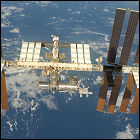 Space Shuttle Endeavour is launched on the 127th shuttle flight, a 16-day mission to the International Space Station to complete the Japanese-built Kibo laboratory facility. The installation of the final Kibo module requires five lengthy spacewalks. Aboard Endeavour for her 23rd flight are Commander Mark Polansky, Pilot Doug Hurley, and mission specialists Christopher Cassidy, Tom Marshburn, Dave Wolf, Julie Payette and Tim Kopra; Kopra remains on the station, with Japanese astronaut Koichi Wakata returning to Earth on the shuttle.
Space Shuttle Endeavour is launched on the 127th shuttle flight, a 16-day mission to the International Space Station to complete the Japanese-built Kibo laboratory facility. The installation of the final Kibo module requires five lengthy spacewalks. Aboard Endeavour for her 23rd flight are Commander Mark Polansky, Pilot Doug Hurley, and mission specialists Christopher Cassidy, Tom Marshburn, Dave Wolf, Julie Payette and Tim Kopra; Kopra remains on the station, with Japanese astronaut Koichi Wakata returning to Earth on the shuttle.
STS-126
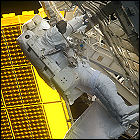 Space Shuttle Endeavour lifts off on a 15-day mission to the International Space Station, carrying more supplies and equipment than any previous shuttle flight bound for the station. Also on tap is a major spacewalk to repair part of the solar panel assembly on the station which allows it to track the sun. Aboard Endeavour for her 22nd flight are Commander Chris Ferguson, Pilot Eric Boe, and mission specialists Steve Bowen, Don Pettit, Shane Kimbrough, Heidemarie Stefanyshyn-Piper and Sandra Magnus. Magnus remains on the International Space Station, while ISS crewmember Greg Chamitoff returns from a six-month stint in space aboard the shuttle.
Space Shuttle Endeavour lifts off on a 15-day mission to the International Space Station, carrying more supplies and equipment than any previous shuttle flight bound for the station. Also on tap is a major spacewalk to repair part of the solar panel assembly on the station which allows it to track the sun. Aboard Endeavour for her 22nd flight are Commander Chris Ferguson, Pilot Eric Boe, and mission specialists Steve Bowen, Don Pettit, Shane Kimbrough, Heidemarie Stefanyshyn-Piper and Sandra Magnus. Magnus remains on the International Space Station, while ISS crewmember Greg Chamitoff returns from a six-month stint in space aboard the shuttle.
STS-123
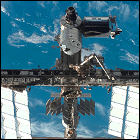 Space Shuttle Endeavour lifts off on the 122nd shuttle flight, a 16 day mission to deliver two new key components of the International Space Station. The unpressurized portion of the Japanese Aerospace Exploration Agency’s Kibo laboratory is delivered and attached, while the two-armed Dextre robotic arm system built in Canada is also installed. Aboard Endeavour for her 21st flight are Commander Dominic Gorie, Pilot Greg Johnson, and mission specialists Garrett Reisman, Robert Behnken, Mike Foreman, Takao Doi and Rick Linnehan. Reisman remains on the ISS, while station astronaut Leopold Eyharts hitches a ride back to Earth aboard the shuttle.
Space Shuttle Endeavour lifts off on the 122nd shuttle flight, a 16 day mission to deliver two new key components of the International Space Station. The unpressurized portion of the Japanese Aerospace Exploration Agency’s Kibo laboratory is delivered and attached, while the two-armed Dextre robotic arm system built in Canada is also installed. Aboard Endeavour for her 21st flight are Commander Dominic Gorie, Pilot Greg Johnson, and mission specialists Garrett Reisman, Robert Behnken, Mike Foreman, Takao Doi and Rick Linnehan. Reisman remains on the ISS, while station astronaut Leopold Eyharts hitches a ride back to Earth aboard the shuttle.
STS-118 puts a teacher in space
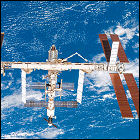 Space Shuttle Endeavour lifts off on the 119th shuttle flight, a 12-day mission to the International Space Station. Additional truss sections are delivered and installed at the station to support solar power arrays, along with the delivery of 5,000 pounds of supplies, consumables and experiments. Aboard Endeavour for her 20th flight are Commander Scott Kelly, Pilot Charles Hobaugh, and mission specialists Richard Mastracchio, Dr. Dafydd Williams, Barbara Morgan, Dr. Tracy Caldwell and Benjamin Drew. Morgan is the first Teacher In Space, having been Christa McAuliffe’s backup in the 1980s, finally fulfilling the Teacher In Space program after 21 years.
Space Shuttle Endeavour lifts off on the 119th shuttle flight, a 12-day mission to the International Space Station. Additional truss sections are delivered and installed at the station to support solar power arrays, along with the delivery of 5,000 pounds of supplies, consumables and experiments. Aboard Endeavour for her 20th flight are Commander Scott Kelly, Pilot Charles Hobaugh, and mission specialists Richard Mastracchio, Dr. Dafydd Williams, Barbara Morgan, Dr. Tracy Caldwell and Benjamin Drew. Morgan is the first Teacher In Space, having been Christa McAuliffe’s backup in the 1980s, finally fulfilling the Teacher In Space program after 21 years.
STS-113 / ISS Expedition 6
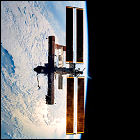 Space Shuttle Endeavour lifts off on the 112th shuttle flight, a two-week mission to resupply and exchange crews at the International Space Station. Another structural tress to dissipate excess heat into space is assembled and attached. Aboard Endeavour for her 19th flight are Commander James Wetherbee, Pilot Paul Lockhart, mission specialists Michael Lopez-Alegria and John Herrington, and ISS Expedition 6 crewmembers Kenneth Bowersox, Nikolai Budarin and Don Pettit. Returning to Earth aboard the shuttle are Expedition 5 crewmembers Valeri Korzun, Peggy Whitson and Sergei Treschev.
Space Shuttle Endeavour lifts off on the 112th shuttle flight, a two-week mission to resupply and exchange crews at the International Space Station. Another structural tress to dissipate excess heat into space is assembled and attached. Aboard Endeavour for her 19th flight are Commander James Wetherbee, Pilot Paul Lockhart, mission specialists Michael Lopez-Alegria and John Herrington, and ISS Expedition 6 crewmembers Kenneth Bowersox, Nikolai Budarin and Don Pettit. Returning to Earth aboard the shuttle are Expedition 5 crewmembers Valeri Korzun, Peggy Whitson and Sergei Treschev.
This is the last successful shuttle mission for over two years.
STS-111 / ISS Expedition 5
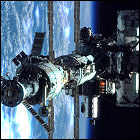 Space Shuttle Endeavour lifts off on the 110th shuttle flight, a mission to exchange the crew of the International Space Station. Scheduled supplies and other equipment are also transported to the station. Aboard Endeavour for her 18th flight are Commander Kenneth Cockrell, Pilot Paul Lockhart, mission specialists Franklin Chang-Diaz and Philippe Perrin, and ISS Expedition 5 crewmembers Valeri Korzun, Peggy Whitson and Sergei Treschev. Returning to Earth aboard the shuttle are ISS Expedition 4 crewmembers Yuri Onufriyenko, Carl Walz and Daniel Bursch.
Space Shuttle Endeavour lifts off on the 110th shuttle flight, a mission to exchange the crew of the International Space Station. Scheduled supplies and other equipment are also transported to the station. Aboard Endeavour for her 18th flight are Commander Kenneth Cockrell, Pilot Paul Lockhart, mission specialists Franklin Chang-Diaz and Philippe Perrin, and ISS Expedition 5 crewmembers Valeri Korzun, Peggy Whitson and Sergei Treschev. Returning to Earth aboard the shuttle are ISS Expedition 4 crewmembers Yuri Onufriyenko, Carl Walz and Daniel Bursch.
STS-108 / ISS Expedition 4
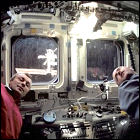 Space Shuttle Endeavour lifts off on the 107th shuttle flight, a resupply and crew rotation mission to the International Space Station. Aboard Endeavour for her 17th flight are Commander Dominic Gorie, Pilot Mark Kelly, mission specialists Linda Godwin and Daniel Tani, and ISS Expedition 4 crewmembers Yuri Onufrienko, Carl Walz and Daniel Bursch. Returning to Earth via Endeavour are ISS Expedition 3 crewmembers Frank Culbertson, Mikhail Turin and Vladimir Dezhurov.
Space Shuttle Endeavour lifts off on the 107th shuttle flight, a resupply and crew rotation mission to the International Space Station. Aboard Endeavour for her 17th flight are Commander Dominic Gorie, Pilot Mark Kelly, mission specialists Linda Godwin and Daniel Tani, and ISS Expedition 4 crewmembers Yuri Onufrienko, Carl Walz and Daniel Bursch. Returning to Earth via Endeavour are ISS Expedition 3 crewmembers Frank Culbertson, Mikhail Turin and Vladimir Dezhurov.
STS-100: fully armed & operational station
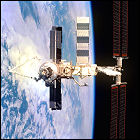 Space Shuttle Endeavour lifts off on the 104th shuttle flight, a 12-day mission to resupply and continue construction of the International Space Station. The primary addition to the station is the Canadian-built remote manipulator arm, derived from the design that has been flown throughout the Space Shuttle program, to be affixed to the station itself. Aboard Endeavour for her 16th flight are Commander Kent Rominger, Pilot Jeff Ashby, and mission specialists Chris Hadfield, Scott Parazynski, John Phillips, Umberto Guidoni and Yuri Lonchakov.
Space Shuttle Endeavour lifts off on the 104th shuttle flight, a 12-day mission to resupply and continue construction of the International Space Station. The primary addition to the station is the Canadian-built remote manipulator arm, derived from the design that has been flown throughout the Space Shuttle program, to be affixed to the station itself. Aboard Endeavour for her 16th flight are Commander Kent Rominger, Pilot Jeff Ashby, and mission specialists Chris Hadfield, Scott Parazynski, John Phillips, Umberto Guidoni and Yuri Lonchakov.
STS-97: increase the power!
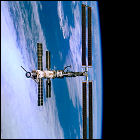 Space Shuttle Endeavour lifts off on an 11-day mission to add a major solar power array to the International Space Station. For the first time, a crew has already arrived via Soyuz and taken up residence on the station prior to the shuttle’s arrival. Another external truss is added, and the first large solar power array – 240 feet long – is added to it, more than quintupling the power available aboard the station. Aboard Endeavour for her 15th flight are Commander Brent Jett, Pilot Michael Bloomfield, and mission specialists Joseph Tanner, Marc Garneau and Carlos Noriega.
Space Shuttle Endeavour lifts off on an 11-day mission to add a major solar power array to the International Space Station. For the first time, a crew has already arrived via Soyuz and taken up residence on the station prior to the shuttle’s arrival. Another external truss is added, and the first large solar power array – 240 feet long – is added to it, more than quintupling the power available aboard the station. Aboard Endeavour for her 15th flight are Commander Brent Jett, Pilot Michael Bloomfield, and mission specialists Joseph Tanner, Marc Garneau and Carlos Noriega.
STS-99
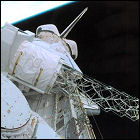 Space Shuttle Endeavour lifts off on the 97th shuttle flight, and the only one on the 2000 launch schedule not devoted to construction of the International Space Station. Instead, Endeavour carries out an 11-day radar topography mission, though the 200-foot radar mast deployed from the cargo bay changes Endeavour’s center of mass and necessitates an unusually high usage of the orbiter’s fuel to keep the vehicle and payload properly oriented. Endeavour’s 14th crew is Commander Kevin Kregel, Pilot Dominic Gorie, and mission specialists Janet Kavandi, Janice Voss, Mamoru Mohri and Gerhard Thiele.
Space Shuttle Endeavour lifts off on the 97th shuttle flight, and the only one on the 2000 launch schedule not devoted to construction of the International Space Station. Instead, Endeavour carries out an 11-day radar topography mission, though the 200-foot radar mast deployed from the cargo bay changes Endeavour’s center of mass and necessitates an unusually high usage of the orbiter’s fuel to keep the vehicle and payload properly oriented. Endeavour’s 14th crew is Commander Kevin Kregel, Pilot Dominic Gorie, and mission specialists Janet Kavandi, Janice Voss, Mamoru Mohri and Gerhard Thiele.
STS-88: laying the ISS cornerstone
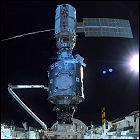 Space Shuttle Endeavour lifts off to begin the construction of the International Space Station. Endeavour conducts a rendezvous with the already-launched Zarya module and attached the Unity station module to it. The two modules’ external connections are completed during a spacewalk, and the station is powered up for the first time on December 7th. Endeavour’s 13th crew is Commander Robert Cabana, Pilot Frederick Sturckow, and mission specialists Nancy Currie, Jerry Ross, James Newman and Sergei Krikalev. Cabana and Krikalev are the first humans to enter the International Space Station, but since the fledgeling facility lacks long-term habitation facilities, it is left unmanned at the end of the 12 day mission.
Space Shuttle Endeavour lifts off to begin the construction of the International Space Station. Endeavour conducts a rendezvous with the already-launched Zarya module and attached the Unity station module to it. The two modules’ external connections are completed during a spacewalk, and the station is powered up for the first time on December 7th. Endeavour’s 13th crew is Commander Robert Cabana, Pilot Frederick Sturckow, and mission specialists Nancy Currie, Jerry Ross, James Newman and Sergei Krikalev. Cabana and Krikalev are the first humans to enter the International Space Station, but since the fledgeling facility lacks long-term habitation facilities, it is left unmanned at the end of the 12 day mission.
STS-89: eighth Shuttle-Mir docking
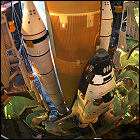 Space Shuttle Endeavour is launched on a nine-day mission to dock with the Russian Mir space station. Routine resupply activities are carried out, along with crew rotations. Endeavour’s crew for her 12th flight consists of Commander Terrence Wilcutt, Pilot Joe Edwards, Payload Commander Bonnie Dunbar, and mission specialists Michael Anderson, James Reilly, Salizhan Sharipov and Andrew Thomas. Thomas remains on Mir, while David Wolf returns to Earth aboard Endeavour.
Space Shuttle Endeavour is launched on a nine-day mission to dock with the Russian Mir space station. Routine resupply activities are carried out, along with crew rotations. Endeavour’s crew for her 12th flight consists of Commander Terrence Wilcutt, Pilot Joe Edwards, Payload Commander Bonnie Dunbar, and mission specialists Michael Anderson, James Reilly, Salizhan Sharipov and Andrew Thomas. Thomas remains on Mir, while David Wolf returns to Earth aboard Endeavour.
STS-77
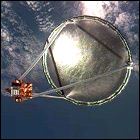 Space Shuttle Endeavour lifts off on the 77th shuttle mission, a ten-day flight to perform experiments in the cargo-bay-mounted SPACEHAB module, and a test of a free-flying inflatible antenna system. The crew also communicates with astronaut Shannon Lucid aboard Mir, though Endeavour and Mir are in different orbits. Aboard Endeavour for her 11th flight are Commander John Casper, Pilot Curtis Brown, and mission specialists Daniel Bursch, Mario Runco, Marc Garneau and Andrew Thomas.
Space Shuttle Endeavour lifts off on the 77th shuttle mission, a ten-day flight to perform experiments in the cargo-bay-mounted SPACEHAB module, and a test of a free-flying inflatible antenna system. The crew also communicates with astronaut Shannon Lucid aboard Mir, though Endeavour and Mir are in different orbits. Aboard Endeavour for her 11th flight are Commander John Casper, Pilot Curtis Brown, and mission specialists Daniel Bursch, Mario Runco, Marc Garneau and Andrew Thomas.
STS-72
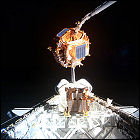 Space Shuttle Endeavour lifts off on the 74th flight of the shuttle program. Over nine days, Endeavour’s crew retrieves a Japanese satellite for return to Earth while deploying a NASA experiment which flies as far as 45 miles away from the shuttle for two days before it, too, is retrieved. More spacewalk techniques and technologies are tried out for future space station construction. Aboard Endeavour for her tenth flight are Commander Brian Duffy, Pilot Brent Jett, and mission specialists Leroy Chiao, Daniel Barry, Winston Scott and Koichi Wakata.
Space Shuttle Endeavour lifts off on the 74th flight of the shuttle program. Over nine days, Endeavour’s crew retrieves a Japanese satellite for return to Earth while deploying a NASA experiment which flies as far as 45 miles away from the shuttle for two days before it, too, is retrieved. More spacewalk techniques and technologies are tried out for future space station construction. Aboard Endeavour for her tenth flight are Commander Brian Duffy, Pilot Brent Jett, and mission specialists Leroy Chiao, Daniel Barry, Winston Scott and Koichi Wakata.
STS-69
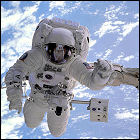 Space Shuttle Endeavour lifts off on the 71st shuttle flight, an 11-day mission to conduct solar wind experiments and test out new spacewalking techniques and space suit revisions for future construction of the International Space Station. Aboard Endeavour for her ninth flight are Commander David Walker, Pilot Kenneth Cockrell, Payload Commander James Voss, and mission specialists James Newman and Michael Gernhardt.
Space Shuttle Endeavour lifts off on the 71st shuttle flight, an 11-day mission to conduct solar wind experiments and test out new spacewalking techniques and space suit revisions for future construction of the International Space Station. Aboard Endeavour for her ninth flight are Commander David Walker, Pilot Kenneth Cockrell, Payload Commander James Voss, and mission specialists James Newman and Michael Gernhardt.
STS-67
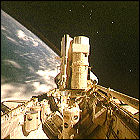 NASA launches Space Shuttle Endeavour on the longest flight of the shuttle program to date – over 16 and a half days – with the ASTRO astronomy experiment package mounted in the cargo bay. Some astronomical observations on this mission are conducted in tandem with the Hubble Space Telescope. Aboard Endeavour for her eighth flight are Commander Stephen Oswald, Pilot William Gregory, Payload Commander Tammy Jernigan, mission specialists John Grunsfeld and Wendy Lawrence, and payload specialists Ronald Parise and Samuel Durrance.
NASA launches Space Shuttle Endeavour on the longest flight of the shuttle program to date – over 16 and a half days – with the ASTRO astronomy experiment package mounted in the cargo bay. Some astronomical observations on this mission are conducted in tandem with the Hubble Space Telescope. Aboard Endeavour for her eighth flight are Commander Stephen Oswald, Pilot William Gregory, Payload Commander Tammy Jernigan, mission specialists John Grunsfeld and Wendy Lawrence, and payload specialists Ronald Parise and Samuel Durrance.
STS-68
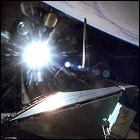 Space Shuttle Endeavour lifts off on the shuttle program’s 65th mission. The eleven-day flight is a second round of space radar experiments, using a cargo-bay-mounted radar system that flew earlier in 1994 aboard Endeavour. The crew for this flight consists of Commander Michael Baker, Pilot Terrence Wilcutt, Payload Commander Thomas Jones, and mission specialists Steven Smith, Daniel Bursch and Peter Wisoff.
Space Shuttle Endeavour lifts off on the shuttle program’s 65th mission. The eleven-day flight is a second round of space radar experiments, using a cargo-bay-mounted radar system that flew earlier in 1994 aboard Endeavour. The crew for this flight consists of Commander Michael Baker, Pilot Terrence Wilcutt, Payload Commander Thomas Jones, and mission specialists Steven Smith, Daniel Bursch and Peter Wisoff.
STS-59
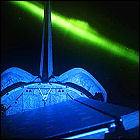 NASA launches Space Shuttle Endeavour on an 11-day mission to carry the Space Radar Laboratory experiment into orbit. The radar systems map sites on Earth and test other applications for orbital radar. Aboard Endeavour for her sixth flight are Commander Sidney Gutierrez, Pilot Kevin Chilton, Payload Commander Linda Godwin, and mission specialists Jay Apt, Michael Clifford and Thomas Jones.
NASA launches Space Shuttle Endeavour on an 11-day mission to carry the Space Radar Laboratory experiment into orbit. The radar systems map sites on Earth and test other applications for orbital radar. Aboard Endeavour for her sixth flight are Commander Sidney Gutierrez, Pilot Kevin Chilton, Payload Commander Linda Godwin, and mission specialists Jay Apt, Michael Clifford and Thomas Jones.
STS-61: new eyes for Hubble
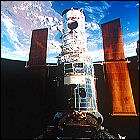 NASA launches Space Shuttle Endeavour on a ten-day mission to retrieve and repair the Hubble Space Telescope, which was launched in 1990 with flawed optics. With the $2,000,000,000 telescope held steady in the cargo bay, Endeavour astronauts conduct repairs during spacewalks totaling over 35 hours of the mission, before releasing Hubble back into orbit with new eyes. Aboard Endeavour for her history-making fifth flight are Commander Richard Covey, Pilot Kenneth Bowersox, Payload Commander Story Musgrave, and mission specialists Kathryn Thornton, Claude Nicollier, Jeffrey Hoffman and Tom Akers.
NASA launches Space Shuttle Endeavour on a ten-day mission to retrieve and repair the Hubble Space Telescope, which was launched in 1990 with flawed optics. With the $2,000,000,000 telescope held steady in the cargo bay, Endeavour astronauts conduct repairs during spacewalks totaling over 35 hours of the mission, before releasing Hubble back into orbit with new eyes. Aboard Endeavour for her history-making fifth flight are Commander Richard Covey, Pilot Kenneth Bowersox, Payload Commander Story Musgrave, and mission specialists Kathryn Thornton, Claude Nicollier, Jeffrey Hoffman and Tom Akers.
STS-57
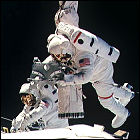 NASA launches Space Shuttle Endeavour on a mission lasting almost ten days to test the SPACEHAB pressurized lab module. A long-term exposure experiment is retrieved for ESA, though a spacewalk must be undertaken when its antennae fail to stow themselves away automatically for insertion into the cargo bay. Aboard Endeavour for her fourth flight into orbit are Commander Ronald Grabe, Pilot Brian Duffy, Payload Commander G. David Low, and mission specialists Nancy Sherlock, Peter Wisoff and Janice Voss.
NASA launches Space Shuttle Endeavour on a mission lasting almost ten days to test the SPACEHAB pressurized lab module. A long-term exposure experiment is retrieved for ESA, though a spacewalk must be undertaken when its antennae fail to stow themselves away automatically for insertion into the cargo bay. Aboard Endeavour for her fourth flight into orbit are Commander Ronald Grabe, Pilot Brian Duffy, Payload Commander G. David Low, and mission specialists Nancy Sherlock, Peter Wisoff and Janice Voss.
STS-54
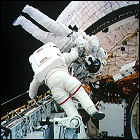 Space Shuttle Endeavour lifts off on the 53rd shuttle flight, a six-day mission to launch the fifth TDRS (Tracking & Data Relay Satellite) and perform assorted experiments. A five-hour spacewalk is conducted in the cargo bay to practice spacewalking techniques for future missions. Aboard Endeavour for her third flight are Commander John Casper, Pilot Donald McMonagle, and mission specialists Mario Runco, Gregory Harbaugh and Susan Helms.
Space Shuttle Endeavour lifts off on the 53rd shuttle flight, a six-day mission to launch the fifth TDRS (Tracking & Data Relay Satellite) and perform assorted experiments. A five-hour spacewalk is conducted in the cargo bay to practice spacewalking techniques for future missions. Aboard Endeavour for her third flight are Commander John Casper, Pilot Donald McMonagle, and mission specialists Mario Runco, Gregory Harbaugh and Susan Helms.
STS-47
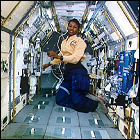 Space Shuttle Endeavour lifts off on the 50th space shuttle mission (and its own first return flight to orbit). Carrying the Spacelab module in its cargo bay, Endeavour hosts the first Japanese shuttle astronaut and the first African-American woman in space. Over eight days, the crew performs various science experiments. Endeavour is flown by Commander Robert “Hoot” Gibson, Pilot Curtis Brown, Payload Commander Mark Lee, missions specialists Jan Davis, Jay Apt and Mae Jemison, and payload specialist Mamoru Mohri.
Space Shuttle Endeavour lifts off on the 50th space shuttle mission (and its own first return flight to orbit). Carrying the Spacelab module in its cargo bay, Endeavour hosts the first Japanese shuttle astronaut and the first African-American woman in space. Over eight days, the crew performs various science experiments. Endeavour is flown by Commander Robert “Hoot” Gibson, Pilot Curtis Brown, Payload Commander Mark Lee, missions specialists Jan Davis, Jay Apt and Mae Jemison, and payload specialist Mamoru Mohri.
STS-49: Endeavour’s first flight
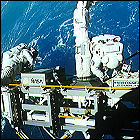 Space Shuttle Endeavour leaves Earth for the first time, carrying a crew of seven to orbit on the 47th shuttle mission. Over nearly nine days, three spacewalks are taken up with the tricky and dangerous task of capturing a four-and-a-half-ton communications satellite into Endeavour’s cargo bay to repair and relaunch it. (The satellite, Intelsat VI, had been stranded in the wrong orbit since its 1990 launch aboard a Titan rocket.) The record-setting spacewalks involved – each lasting over seven hours and marking the first time three astronauts have operated outside their vehicle – force NASA to cancel one of two experimental EVAs to test space station construction techniques. Endeavour’s first crew consists of Commander Daniel Brandenstein, pilot Kevin Chilton, and mission specialists Pierre Thuot, Kathryn Thornton, Richard Hieb, Thomas Akers and Bruce Melnick.
Space Shuttle Endeavour leaves Earth for the first time, carrying a crew of seven to orbit on the 47th shuttle mission. Over nearly nine days, three spacewalks are taken up with the tricky and dangerous task of capturing a four-and-a-half-ton communications satellite into Endeavour’s cargo bay to repair and relaunch it. (The satellite, Intelsat VI, had been stranded in the wrong orbit since its 1990 launch aboard a Titan rocket.) The record-setting spacewalks involved – each lasting over seven hours and marking the first time three astronauts have operated outside their vehicle – force NASA to cancel one of two experimental EVAs to test space station construction techniques. Endeavour’s first crew consists of Commander Daniel Brandenstein, pilot Kevin Chilton, and mission specialists Pierre Thuot, Kathryn Thornton, Richard Hieb, Thomas Akers and Bruce Melnick.
Endeavouring to keep spares on hand
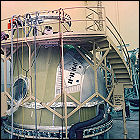 At Rockwell International, a spare Space Shuttle crew module is assembled alongside components intended for the orbiters Discovery and Atlantis, and though the spare isn’t intended for a specific shuttle yet to be built, it will find a purpose in the wake of the 1986 Challenger disaster: the spare crew module will become one of many completed shuttle spares that will eventually be assembled in the late 1980s as the Space Shuttle Endeavour, Challenger’s replacement and the last space shuttle constructed.
At Rockwell International, a spare Space Shuttle crew module is assembled alongside components intended for the orbiters Discovery and Atlantis, and though the spare isn’t intended for a specific shuttle yet to be built, it will find a purpose in the wake of the 1986 Challenger disaster: the spare crew module will become one of many completed shuttle spares that will eventually be assembled in the late 1980s as the Space Shuttle Endeavour, Challenger’s replacement and the last space shuttle constructed.